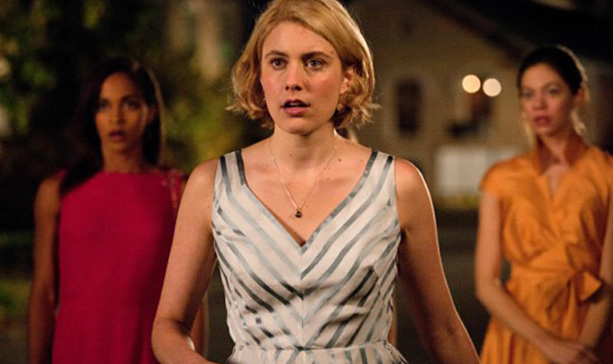Culture
No “Distress” for Stillman’s return

Damsels in Distress
dir. Whit Stillman
Release Date: Apr 13, 12
- 1
- 2
- 3
- 4
- 5
- 6
- 7
- 8
- 9
- 10
I can’t remember the last time I saw a film as giddily buoyant and joyous as Whit Stillman’s new comedy, Damsels in Distress, a movie so uproariously witty I had to take off my glasses after the first fifteen minutes because my laughter kept crying into them. Like many of Stillman’s films, it’s the kind of movie you’re tempted to say that Hollywood doesn’t make anymore; however, I can’t remember if I’ve ever seen a movie quite as effervescently daffy as this.
Damsels in Distress bears no relation to the real world or any universe that I’ve ever encountered. Its main characters run a Suicide Prevention Clinic that specializes in tap dance therapy, and the heroine wants to make the world a better place through starting a dance craze, but it commits so singularly to its own mad world that it’s impossible not to be swept up in it. Taking place in a candy-colored universe that looks like Tim Burton’s take on a J. Crew ad, the film is set at an East Coast Seven Sisters school seemingly only populated by characters from P.G. Wodehouse novels. All of them speak in the arch affectations that comprise the first language of every Whit Stillman character, and their most pressing concerns are housing homeless frat boys.
There isn’t much of a plot to the whole thing, as the movie doesn’t require it. It’s not about that, exactly. Damsels in Distress centers on a group of women at the college who take men and improve them to make them presentable males. This is partially Stillman’s own commentary about the disheveled state of modern males, but without the histrionics that marred Tom Wolfe’s I Am Charlotte Simmons, where Wolfe’s out-of-touchness made the novel sound like another old fogey railing against the whippersnappers. Instead, Stillman makes the Damsels and their leader (Greta Gerwig) as much the butt of the joke as the men they try to improve, and like every Wodehouse novel, all of the characters are equally loony, just in different ways.
Unlike Wolfe, Stillman has lost none of his sharp comedic wit in his transition from being at the zeitgeist of American independent cinema to a forgotten bygone anecdote within it. Oddly, not only does this film prove him sharper than ever (only Metropolitan, his first film, is superior), but I also argue that his style makes more sense now that it ever did in the 90s. As the forefather of Wes Anderson and Jason Reitman, the idea of the hyper-literate indie comedy had not quite had its heyday, and Stillman’s most obvious influence (Woody Allen) was caught in the beginning of his decade-long tailspin into making that movie with Helen Hunt. With an entire genre around him and a decade of prepster culture behind him, Stillman makes more sense now than he ever did, and his Urban Haute Bourgeoisie is no longer just an auteurist fantasy.
It also helps that Stillman’s Busby Berkeley dreams found their waking muse in Greta Gerwig. In this film, Gerwig gives the performance that Stillman has always been searching for in his actresses, the female counterpart to the Chris Eigeman role in his other movies. Gerwig’s Violet is somehow poised, composed and hyper-intelligent while also utterly insane, like a J.D. Salinger creation recently released from an asylum. She always seems both in total control of her faculties and instantly ready to have a meltdown, in the way many liberal arts college students are. And Annaleigh Tipton, eschewing the same omnipresent vulnerability as she showed in Crazy, Stupid, Love, acts as her perfect foil, a new student to the university who seems to be cloned directly out of Rory Gilmore’s cells. Unlike Violet, she’s not sure about anything, including the correct way to have sex with her French boyfriend. (Hint: His religious beliefs only allow him to enjoy the rear side of her body).
This description doesn’t even begin to get at the madcap wonder that is this film or the ways in which Stillman makes these characters both completely farcical and unreal yet magnetically relatable. Like every 80s film, Damsels in Distress ends with a semi-climactic dance sequence (one in which the world’s future happiness rests in the balance), and after the dance ends, the film provides you with instructions as to how to do it at home. Stillman knows that it’s not enough to create your own universe; you should invite other people to participate in it, too. Please, try this one at home.